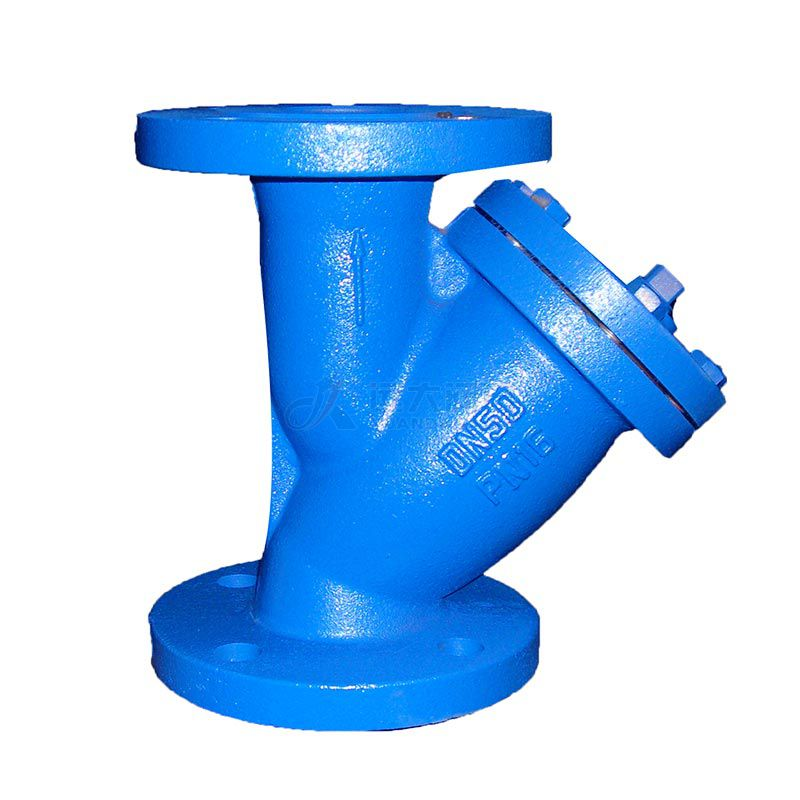In industrial piping systems, a DIN cast iron strainer valve plays a vital role in protecting downstream equipment from damage caused by solid impurities in the medium. As seen in Yuanda Valve Group’s product range, these strainers are designed according to DIN (Deutsches Institut für Normung) standards, ensuring consistent dimensions, performance, and quality for European and international markets.
A strainer valve is a type of pipeline fitting used to remove solid particles from fluids such as water, steam, gas, or oil. It prevents rust, welding slag, and other debris from entering pumps, flow meters, control valves, and other precision equipment.
Yuanda’s DIN cast iron strainers are typically Y-type strainers, named after their Y-shaped body structure. This design offers both compact installation and efficient filtration.

A standard DIN cast iron strainer valve consists of several main parts:
Body: Made of high-grade cast iron such as GG25 or GGG40, suitable for medium-pressure and temperature systems.
Screen or Mesh: Usually stainless steel or perforated metal that traps solid impurities.
Cover or Cap: Allows for easy maintenance and screen cleaning.
Drain or Blow-off Port: Enables flushing or removal of collected debris without removing the valve from the line.
Flanged or Threaded Ends: Manufactured according to DIN standards for reliable pipeline connection.
This durable construction ensures long service life and reliable performance even under demanding operating conditions.
The working process of a DIN cast iron strainer valve is simple but highly effective:
Fluid Inlet and Filtration:
The medium enters through the inlet and passes through the internal strainer mesh. Solid particles are trapped on the mesh surface, while clean fluid flows out through the outlet.
Pressure Differential Formation:
As debris accumulates on the strainer screen, a pressure difference develops between the inlet and outlet. The higher the debris accumulation, the greater the pressure drop.
Cleaning and Maintenance:
When the pressure difference reaches a certain level, it indicates that the strainer requires cleaning. The operator can remove the cover or open the blow-off valve to discharge impurities.
In systems equipped with a blow-down port, cleaning can even be performed without stopping the flow.
Return to Normal Operation:
After cleaning, the system resumes normal operation with reduced pressure loss and restored flow efficiency.
This continuous filtration cycle ensures long-term protection for pumps, valves, and other critical components.
Compliant with DIN/EN Standards: Ensures precise dimensions and compatibility with European piping systems.
Durable Cast Iron Construction: Excellent mechanical strength and corrosion resistance for water, steam, and oil applications.
Replaceable Stainless Steel Screen: Easy to clean or replace for extended service life.
Compact Y-Type Design: Reduces space requirements and allows horizontal or vertical installation.
Optional Blow-off Valve: Enables continuous cleaning without system shutdown.
These design features make Yuanda strainers a reliable and economical choice for industrial users.
Proper installation is essential for efficient operation and easy maintenance:
Flow Direction: The arrow on the valve body must match the flow direction of the pipeline.
Horizontal Installation: The Y-branch should point downward so that debris can settle and be drained easily.
Vertical Installation: Only allowed when the fluid flows from top to bottom to prevent impurities from re-entering the system.
Maintenance Space: Leave enough clearance for removing the cover and cleaning the screen.
Support: Large-diameter strainers should be properly supported to avoid stress on the pipeline.
Pressure Monitoring: Installing pressure gauges before and after the strainer helps determine when cleaning is needed.
Following these steps ensures reliable performance and long-term service.
DIN cast iron strainer valves are widely used across various industries, including:
Water treatment and distribution systems
HVAC and heating systems
Petrochemical and oil industries
Steam and condensate lines
Power plants and boiler systems
Urban construction and environmental engineering
Their main function is to protect downstream equipment, reduce maintenance frequency, and extend the overall lifespan of the system.
Strong protection for pumps, valves, and meters from mechanical damage
Improved system efficiency due to clean fluid flow
Low maintenance cost thanks to reusable and easy-to-clean filters
Wide adaptability for liquids, gases, and steam systems
Cost-effective solution with reliable performance for medium-pressure operations
A DIN cast iron strainer valve is an essential part of any industrial piping system that handles liquids or gases. It works by filtering out impurities through a mesh screen, preventing damage and maintaining stable flow.
Yuanda’s DIN standard strainers combine robust cast iron construction, efficient Y-type design, and easy maintenance, making them an ideal choice for various industrial applications.
By understanding how these valves work and following proper installation and maintenance
Previous: None